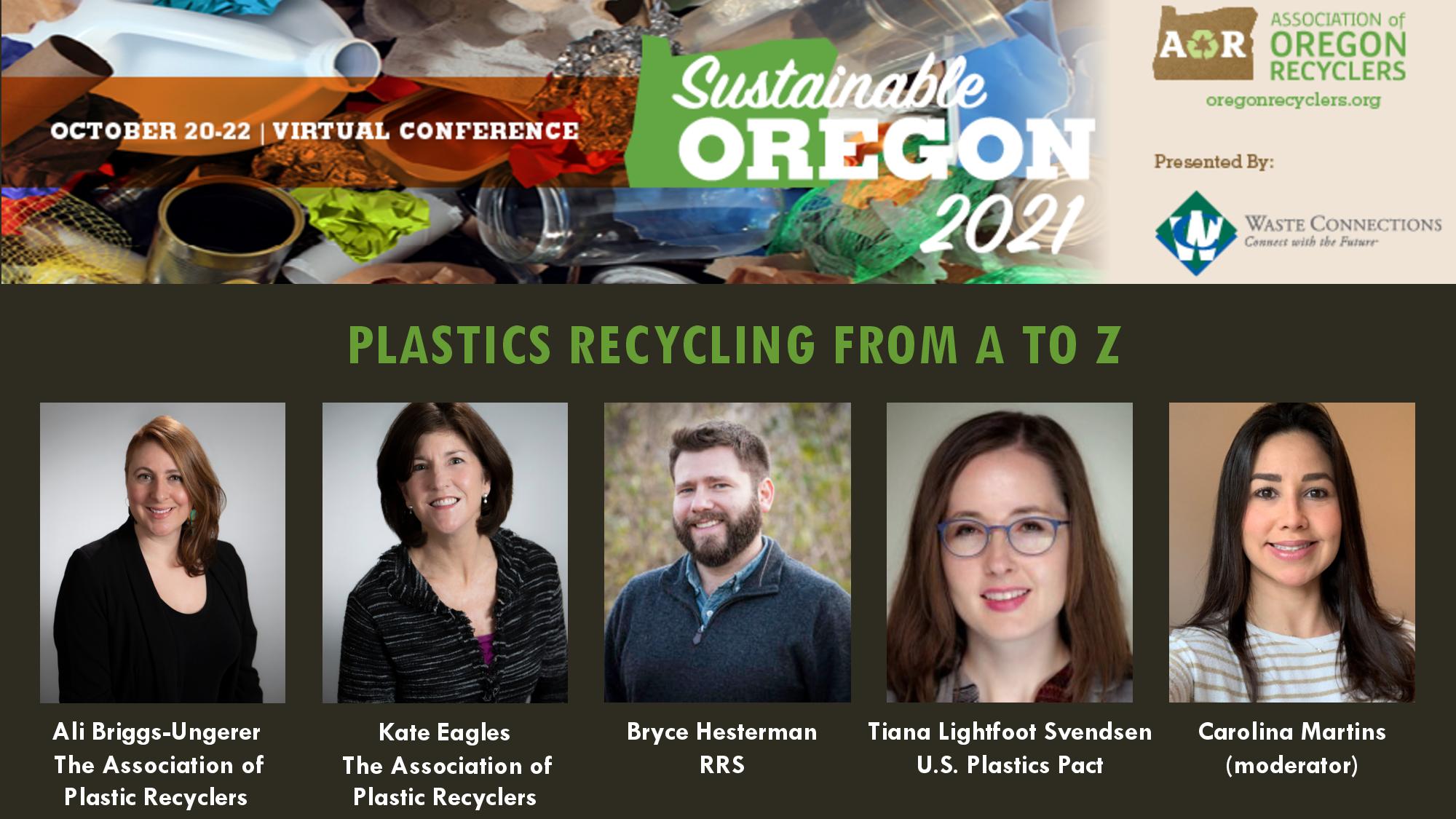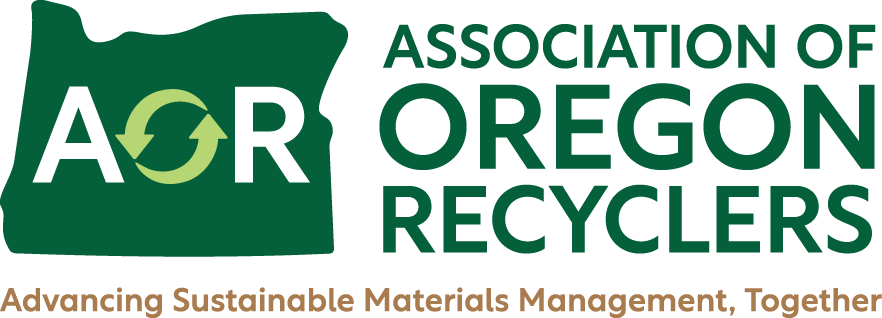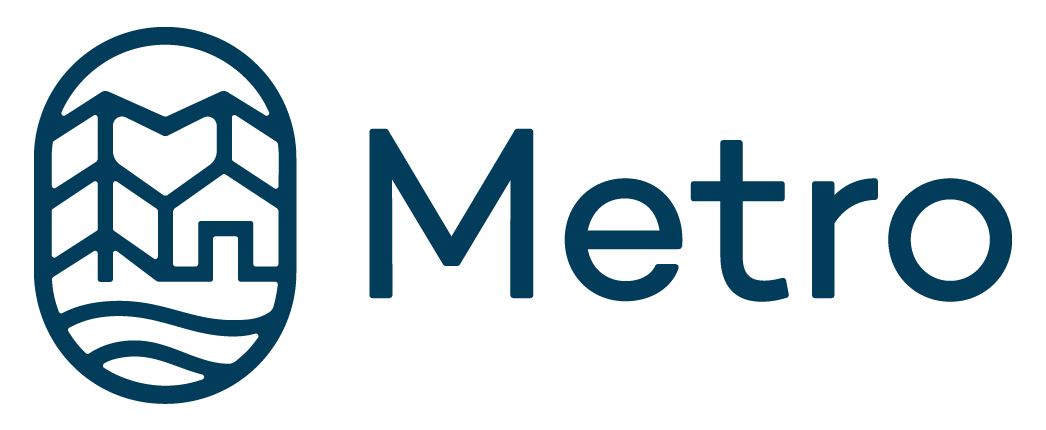SESSION SUMMARY: Plastics Recycling From A to Z
This is a summary of "Plastics Recycling From A to Z," one of Sustainable Oregon 2021's virtual conference sessions. Scholarship recipients are asked to write a blog post about one of the sessions they attend. Thank you to our Scholarship Sponsor Metro for funding scholarships for this year's conference. This session was sponsored by the Association of Plastic Recyclers. A special thank you to Sustainable Oregon 2021's Title Sponsor Waste Connections.
Written by: Heather Trim, Executive Director, Zero Waste Washington
 APR discussed recycling basics and emphasized their guides. In the APR guidelines, for a product to be considered recyclable, the item needs to have collection access, MRF and processing capabilities, and end markets to make it into a new product. RSS covered national market trends. After three decades of effort, most plastic is still destined for waste disposal (82%). Only 18% is going to new products. The balance between what is exported versus what stays locally for recovery and recycling has shifted dramatically to domestic in the last few years. The average revenue of the basket of commodities from single-stream recycling in the past two years (September 2019 to today) has reached the highest price of the last decade. Plastics are 30% of the average commodity revenue for a single stream typical MRF in the U.S. Most plastics bale types have gone up in value except for mixed plastics. Mixed plastics have stayed low because the MRFs are motivated to create those other bales, due to the high market value at the moment. For PET, there has been an upward swing since October. In Oregon, the pricing of PET relative to the rest of the U.S. is lower because of the locations of the reclaimers. The bottle reclaimers are not located in the Pacific Northwest. The pricing is set where they are buying the material from (the loading dock at the MRF) and thus the reclaimers have to pay for transportation. Much PET is going into carpet in the Southeast. High-quality PETs from deposit material goes into food and beverage packaging. HDPE similarly is lower value in Oregon because the reclaimers are mostly east of the Rockies. HDPE is not being recycled into food-grade in significant quantities at the moment. There is significant progress ongoing to reclaim polypropylene. Most polypropylene was in 3-7 bales until recently, but now there is a push for polypropylene resin-specific bales. Most polyethylene film is sourced from commercial generators, such as clear and clean film from back-of-house. About 19% of film is through store drop-off. Less than 1% goes through MRFs because it is difficult to sort out film at MRFs. The Pacific Northwest market value for film is higher than other regions of the U.S., but the reason is unclear. The film primarily goes into durable goods such as lumber and decking (46% of the use). Voluntary post-consumer recycled content goals by brands have helped drive the market as well as mandatory PCR laws in California and Washington states. COVID has helped push demand as well.
APR discussed recycling basics and emphasized their guides. In the APR guidelines, for a product to be considered recyclable, the item needs to have collection access, MRF and processing capabilities, and end markets to make it into a new product. RSS covered national market trends. After three decades of effort, most plastic is still destined for waste disposal (82%). Only 18% is going to new products. The balance between what is exported versus what stays locally for recovery and recycling has shifted dramatically to domestic in the last few years. The average revenue of the basket of commodities from single-stream recycling in the past two years (September 2019 to today) has reached the highest price of the last decade. Plastics are 30% of the average commodity revenue for a single stream typical MRF in the U.S. Most plastics bale types have gone up in value except for mixed plastics. Mixed plastics have stayed low because the MRFs are motivated to create those other bales, due to the high market value at the moment. For PET, there has been an upward swing since October. In Oregon, the pricing of PET relative to the rest of the U.S. is lower because of the locations of the reclaimers. The bottle reclaimers are not located in the Pacific Northwest. The pricing is set where they are buying the material from (the loading dock at the MRF) and thus the reclaimers have to pay for transportation. Much PET is going into carpet in the Southeast. High-quality PETs from deposit material goes into food and beverage packaging. HDPE similarly is lower value in Oregon because the reclaimers are mostly east of the Rockies. HDPE is not being recycled into food-grade in significant quantities at the moment. There is significant progress ongoing to reclaim polypropylene. Most polypropylene was in 3-7 bales until recently, but now there is a push for polypropylene resin-specific bales. Most polyethylene film is sourced from commercial generators, such as clear and clean film from back-of-house. About 19% of film is through store drop-off. Less than 1% goes through MRFs because it is difficult to sort out film at MRFs. The Pacific Northwest market value for film is higher than other regions of the U.S., but the reason is unclear. The film primarily goes into durable goods such as lumber and decking (46% of the use). Voluntary post-consumer recycled content goals by brands have helped drive the market as well as mandatory PCR laws in California and Washington states. COVID has helped push demand as well.
Overall there is not enough supply to feed the demand (i.e., a supply lag), especially for high-quality food-grade material. High demand does not automatically translate into increase in supply. Supply is driven through local collection programs. Consumers don’t see that price signal. There are policies that can focus on supply-side strategies such as EPR and bottle deposit laws. And products need to be designed in such a way that recycling them is economical. APR is helping influence the design of products by brands in a way that flows through the system smoothly. Design for recycling (and APR has a design guide, as well as a recognition program) is important including labels (inks, adhesive) size, color, polymer, shape, and additives. Other barriers to recyclability that apply to pouches, films, thermoforms, and black plastics include some of these challenges: low volume (not enough of that material to justify sorting), transitional packaging (only some in the category are recyclable today), and inconsistent market signals where buyers are coming in and out of the market.
Brands are being motivated by increased public pressure because of concerns about plastic pollution. The U.S. Plastic Pact was started in 2020 and is part of the Ellen MacArthur Foundation’s global plastics pact network. It is a consortium of over 100 businesses, governments, and organizations. The Pact has developed has four targets: define a list in 2021 of problematic or unnecessary materials that should be eliminated by 2025; all plastic packaging be reusable, compostable, or recyclable by 2025; effectively recycle or compost 50% of plastic packaging by 2025; and have an average of 25% PCR or responsibly sourced biobased content by 2025. Progress is tracked in an online dashboard. They are looking for more participation in the Pact by local governments. Oregon’s new Recycling Modernization Act includes many features that will have significant impacts on recycling.
The biggest barrier to building a reclamation plant is access to sufficient volumes of feedstock that is the right material/format and quality. Funding is contingent on guaranteed supply.


